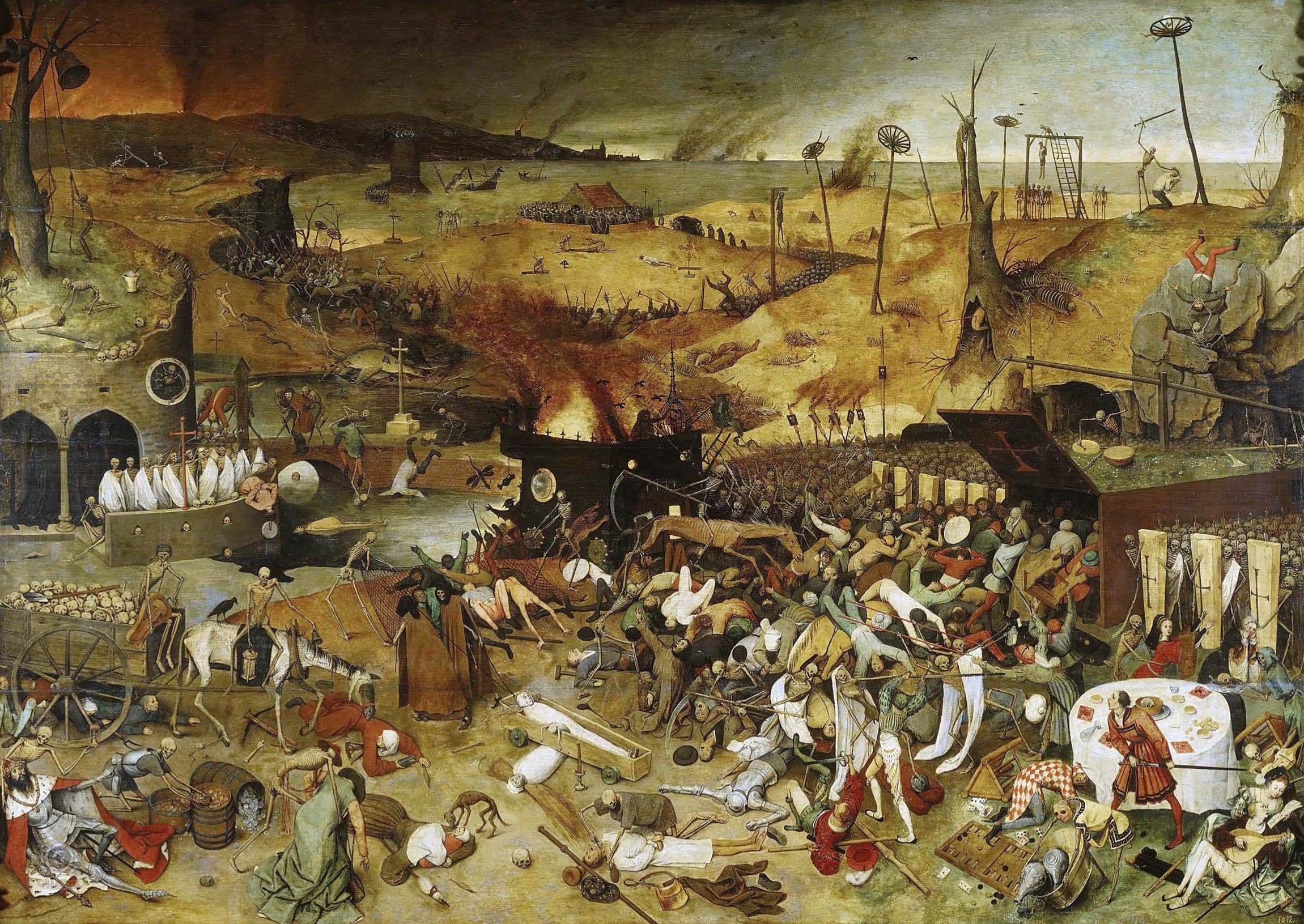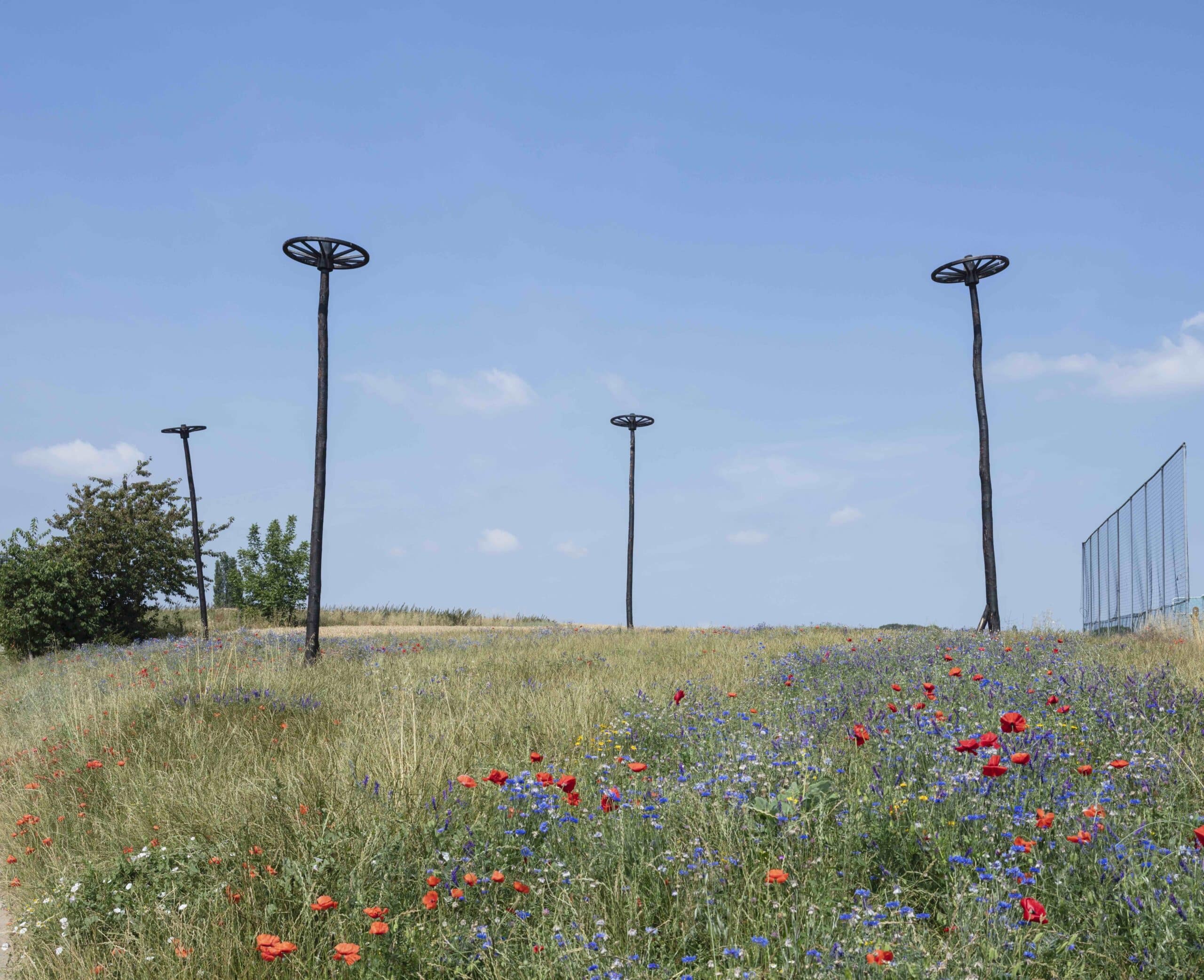Pieter Bruegel the Elder’s Implements of Torture in the Contemporary Landscape
Brussels landscape architect Bas Smets has fallen under the spell of the landscape paintings of Pieter Bruegel the Elder (ca.1525-1569). Smets reconstructed a fragment of The Triumph of Death in the landscape of Brabant.
Pieter Bruegel the Elder composed his landscapes as collages of fragments. He did not attempt to depict reality by painting on-site, but, working in his studio, combined typical Brabantine elements with fragments of what he had seen during his travels in Italy. Rock formations, deep valleys, steep cliffs, groups of trees and tumbling brooks are depicted as one coherent whole, in a bid to compose an imaginary and exemplary landscape that helps to enrich the scene. If Joachim Patinir (1480-1524) is considered as the inventor of landscape paintings with atmospheric perspective, then Bruegel raised this genre to an even higher level.
As a landscape architect, I have the habit of dissecting existing landscapes into their individual elements; elements that are connected by internal logic. Working with a thorough knowledge of that logic, my firm intervenes in physical reality. Our method begins with the examination of aerial photos and thematic maps. Over the past twelve years, we have analysed and subsequently transformed many areas in this way.
 Pieter Bruegel the Elder, The Triumph of Death, ca. 1562, Museo nacional del Prado, Madrid
Pieter Bruegel the Elder, The Triumph of Death, ca. 1562, Museo nacional del Prado, Madrid© Museo nacional del Prado
In 2019, the 450th anniversary of Breugel’s death, I was invited to undertake an intervention in the Pajottenland, near Dilbeek (in the outskirts of Brussels). We – together with fifteen other artists and architects – created a walking route along sites Bruegel often visited: In Bruegel’s Eyes.
For years I’ve been an ardent admirer of the art of the Low Countries from the fifteenth and sixteenth centuries, but my attention is particularly drawn to works by Rogier van der Weyden and Joachim Patinir. I did not know much about Bruegel’s work. Maybe it was due to the early influence of the cartoon Suske en Wiske (Spike and Suzy) that I mentally catalogued Bruegel as the painter of peasant festivals. I thought that he was part of the scene but not very useful for research into the landscape. Nothing could be further from the truth.
Vertical elements in horizontal landscapes
It was not until the ‘highlights’ exhibition in Vienna that I understood the worth and importance of Bruegel the Elder as a landscape painter. I was impressed with the compositive power of his landscapes. With this new insight and the catalogue in my hands, I returned to my office in Brussels. We decided to analyse Bruegel’s paintings the same way we analysed existing topography: by dissecting the whole into its component parts. We did this with seven works: Hunters in the Snow, The Gloomy Day, The Return of the Herd, The Census at Bethlehem, The Procession to Calvary, Winter Landscape with Ice Skaters and Bird Trap, and The Triumph of Death.
In each of these paintings, we dissected the buildings, streams, rocks, bushes, trees and characters. As always, we tried to embark upon this dissection without bias. This examination highlighted the importance of vertical elements in the composition of Bruegel’s horizontal landscapes.
Our examination highlighted the importance of vertical elements in the composition of Bruegel’s horizontal landscapes
The (vertical) trees provide continuity to the landscape and emphasise the lay of the land. From the high ground, they lead the viewer’s gaze into the depths of the background. This is perhaps clearest in the two winter landscapes, Hunters in the Snow and Winter Landscape with Ice Skaters and Bird Trap where the background is obscured by a layer of heavy, white snow.
Intrigued by this discovery, we systematically segregated all the vertical elements. Trees, both living and dead, but also other wooden elements such as gallows, crosses and wheels work together to give the many activities in the painting their own rhythm and lead the eye deep into the background. On some works, there are only trees, as in Hunters in the Snow. In other paintings, there are trees as well as the rigging of a fort, as in The Procession to Calvary. The most noteworthy result arose from our examination of The Triumph of Death (held by the Prado Museum in Madrid). That canvas from about 1562 has a special place in Bruegel’s body of work. It depicts an apocalyptic landscape representing Hell on Earth.
'The Triumph of Death' depicts an apocalyptic landscape representing Hell on Earth
The last living trees have just been cut down and the only vertical elements that remain are the gallows and torture wheels framed by two dead, hollow trees.
These instruments of torture take on the compositional function of the trees: their vertical stretch provides a rhythm to the landscape and leads the eye to the horizon. Did Bruegel mean for the gallows and wheel to work as counterpoints to the trees? It seems as if they mark the physical transformation of the living trees into deadwood and also the symbolic transformation of life-giving trees into bringers of death: gallows and torture wheels.
Instruments of torture as birds’ nests
I wanted to work with this powerful metaphor and decided to re-create a fragment from this painting as faithfully as possible. In the top right corner of The Triumph of Death there are four torture wheels on sloping terrain. After some reconnaissance, we chose the Kappelle field in Dilbeek for its similarity to the terrain in Bruegel’s painting. With the help of the Callebaut brothers, a family of carpenters from Dilbeek, we set up four torture wheels on the site. We based our design of these structures on one held by a museum in Berlin. In front of the posts, we felled four trees from a piece of property owned by the Callebauts and situated the four wheels between a mobile phone mast and the electric light poles of the adjacent football field. They look more like bird’s nests than anything else.
 Bas Smets, Des crayen ende raeven aes, installation in Dilbeek (Pajottenland), 2019
Bas Smets, Des crayen ende raeven aes, installation in Dilbeek (Pajottenland), 2019© Studio Bas Smets
The title of the work was derived from a caption ascribed by painter and biographer Karel van Mander (1548-1606) to The Triumph of Death: “Des crayen ende raeven aes.” With this, Van Mander referred to the victims of the torture wheel who served as carrion for crows and ravens. We hoped that some of the many birds that fly over the Pajottenland would land on or build nests on these poles. That would lead to a jarring juxtaposition of perception and meaning. What at first glance seemed friendly and inviting would, in reality, be an indication of a fearful past.
While a painter rearranges the existing reality in his painting to create a compositional whole, the landscape architect draws plans that effectively transform reality. By actually recreating a fragment from Bruegel’s painting, in a place where Bruegel himself could have seen it, we have come full circle. Through an anachronistic gesture, we realised a fragment on which Bruegel could have based his painting.












